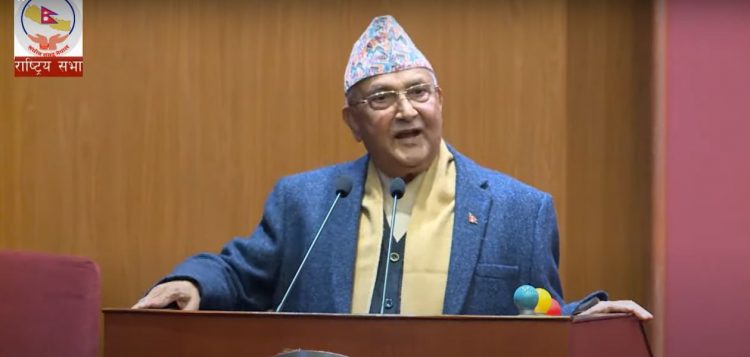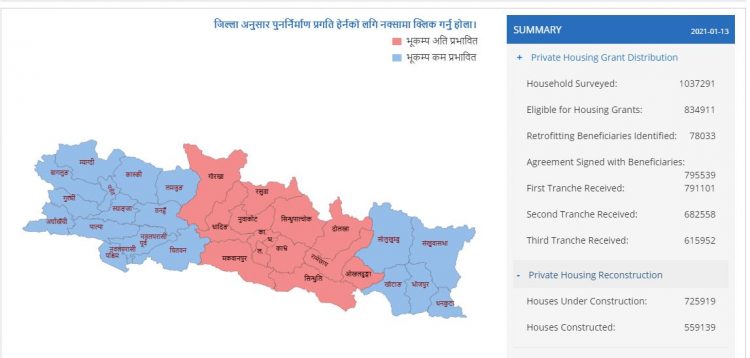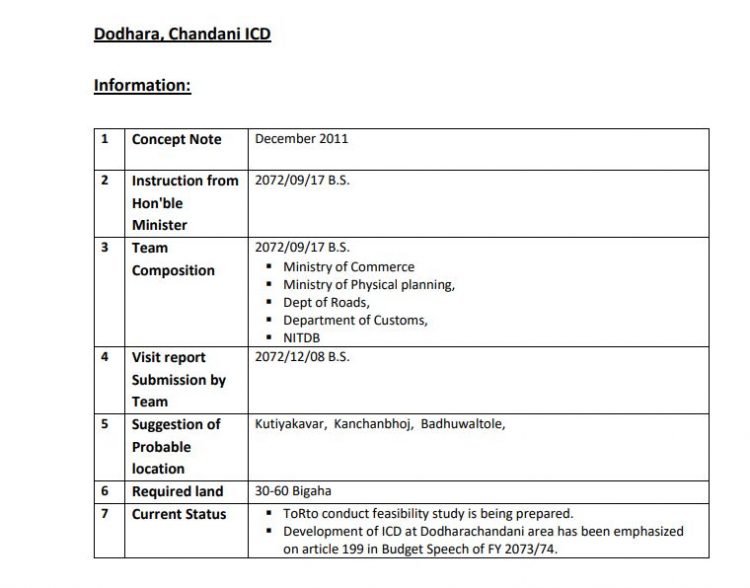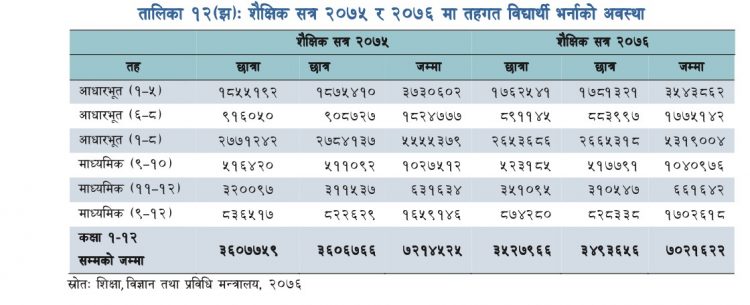PM Oli made some misleading claims in upper house
South Asia Check / January 13, 2021

By Deepak Adhikari
On January 10, Prime Minister KP Sharma Oli during his more than an hour-long address to the National Assembly defended several measures taken by his government including the dissolution of the House of Representatives. Highlighting his government’s achievements he said, “Never before had the works progressed so expeditiously. The facts and figures speak for themselves.”
But some of the claims Oli made during his speech were either misleading or false. South Asia Check fact-checked three of his claims.
First claim
“700,000 earthquake-damaged homes were built and distributed to the people.”
Prime Minister Oli has repeatedly claimed that his government has made significant progress in post-quake reconstruction. But this claim is misleading. According to the National Reconstruction Authority (Prime Minister Oli himself is the chair of the steering committee of the authority), the number of homes completed so far is 559,139. Earlier also, we had fact-checked this claim.

Prime Minister Oli claimed the government distributed the homes to the people. In reality, the government provides a housing grant of Rs 300,000 each to the earthquake-affected people. The grant is released in three installments to the beneficiaries who comply with the government’s reconstruction guidelines. The grant is inadequate and can support only a part of the housing reconstruction. The earthquake-affected people themselves made up for the shortfall amount to build the homes. So Oli’s claim is misleading.
Second claim
“We have made arrangements for a dry port in Chandani-Dodhara.”
Oli said this while claiming that his government has expedited various projects in the Sudurpaschim province. The prime minister occasionally cites Chandani-Dodhara as an example while claiming that Nepal-India relations have improved.
But the dry port project in Dodhara-Chandani Municipality across the Mahakali River has remained a work-in-progress for almost a decade now. According to a recent report in The Kathmandu Post, the World Bank had conducted a feasibility study for the construction of a dry port at Kanjabhoj in Dodhara- Chandani Municipality around ten years ago. In 2016, the Nepal Intermodal Transport Development Board under the Ministry of Commerce had conducted another feasibility study for the project. A technical study, led by Prakash Dahal, a joint secretary at the Ministry of Commerce, submitted a report to the government last October. The panel recommended constructing the dry port in the municipality’s Mayapuri community forest area. A master plan is in the works and it will take two years to complete a detailed project report and environmental impact assessment, according to The Kathmandu Post.

Source: Nepal Intermodal Transport Development Board’s website.
According to a document published on the website of the Nepal Intermodal Transport Development Board, an inter-ministerial level team had conducted a field study and submitted its report five years ago. The concept note of the project was prepared in December 2011, according to the document. The construction of the dry port was also emphasized on the fiscal budget of 2016/17, according to the document.
Therefore, Prime Minister Oli’s claim regarding the project, which is 10 years old but still remains only on paper, is misleading.
Third claim
“Everyone knows how much progress has been made in the education and health sectors. Everyone is well informed about the current school enrollment rate. They also know that the school dropout numbers have gone down. The girl to boy (school enrollment) ratio has become even.”
In his address, Prime Minister Oli claimed that the school enrollment rate for girls has increased and is now almost equal to that of boys. He made the claim while talking about his government’s achievements over the past three years. In fact, several initiatives on gender equality in Nepal’s school education over the past several years have helped in narrowing this gap. Educationists identified the girl children’s lack of access to school education as the main reason for their low enrollment. The government’s economic survey reports show that the number of girls enrolled in schools has already surpassed that of boys. And this happened even before Oli came to power.
According to the Economic Survey of 2017/18, 3790589 girls were enrolled in schools in 2017. Compared to boys, there were 135,080 more girls enrolled in schools that year. Oli became Prime Minister in February 2018.

According to the Economic Survey of 2019/20, 993 more girls were enrolled in schools in 2019 (second year of the Oli government) compared to boys. That year, 3607759 girls were enrolled in schools; the enrollment ratio was almost even. And in 2020, 34,310 more girls were enrolled in schools than boys. That year, the girl enrollment was around 3.5 million. Therefore, Oli’s claim that girl enrollment increased after he came to power is false because the enrollment rate had already equaled before Oli became Nepal’s prime minister.
This material is copyrighted but may be used for any purpose by giving due credit to southasiacheck.org.
Comments
Latest Stories
- In Public Interest Covid-19 cases are low, but that’s not an excuse to avoid vaccination
- In Public Interest What is BF.7, the sub-variant that has the world by its grip?
- In Public Interest Threat of a new Covid-19 wave looms large amid vaccine shortage in Nepal
- In Public Interest As cases decline, Covid-19 test centres in Kathmandu are desolate lot
- In Public Interest Dengue test fee disparity has patients wondering if they’re being cheated
- In Public Interest As dengue rages on, confusion galore about what it is and what its symptoms are. Here’s what you need to know
In Public Interest
 Covid-19 cases are low, but that’s not an excuse to avoid vaccination
The Pfizer-BioNTech bivalent vaccines authorised by the Nepal Government provide better protection a...
Read More
Covid-19 cases are low, but that’s not an excuse to avoid vaccination
The Pfizer-BioNTech bivalent vaccines authorised by the Nepal Government provide better protection a...
Read More
- What is BF.7, the sub-variant that has the world by its grip?
- Threat of a new Covid-19 wave looms large amid vaccine shortage in Nepal
- As cases decline, Covid-19 test centres in Kathmandu are desolate lot
- Dengue test fee disparity has patients wondering if they’re being cheated
- As dengue rages on, confusion galore about what it is and what its symptoms are. Here’s what you need to know